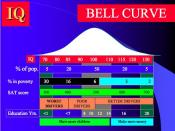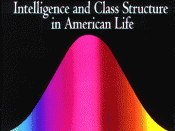Hunters, Gathers and 20th Century American Culture
"Now I will tell you about culture. Culture is that garden. This is not a thing of nations. It is not about Goathe and yeshivas. Culture is the simple grass through which the wind blows sweetly and each grass blade bends softly to the caress of the wind. It is like a mother who would pick up her child and kiss it, with her tenderness that she gave birth to it. We don't see this anymore. In the present time we see nations. They are not natural outgrowings. Their roots are too harsh. They grew up too fast. They have not got that natural sweetness."
Schmuel Goldman
The Bell Curve attempts to address the difficult subject of people as related to success or failure within our culture, and how we as Americans are adjusted to and in most regards still adjusting to an ever-changing American culture.
Does the bell curve represent the reemergence on a major scale, eugenic thinking within the fabric of American culture? My theory is that; The Bell Curve does not represent a shift towards eugenic thinking in American culture. "Gossip about who in the tribe is cleverest has probably been a topic of conversation around the fires since fires, and conversation, were invented."(1) The Bell Curve does however, shed light on major yet underlying trends in American culture. Eugenics as defined by eugenicists of the previous century, deals with the notion of a persons or group of persons fitness in the culture based on heritable traits. "Sir Francis Gaul ton ? choose the great families of Britain as a primary source of data? that intellectual capacity of various sorts ran in families in Hereditary Genius?." I am sure that they probably forgot to mention if they actually had any...


